The VistaScope models from Molecular Vista are supplied with the revolutionary Photo-induced Force Microscopy (PiFM) mode, capable of measuring the sample’s polarizability with high sensitivity and nanometer spatial resolution.
At its core, the VistaScope is a high-performance and high-resolution AFM with a state-of-the-art controller and exceptional top optics for an overhead view of the sample and tip. PiFM signal is greatly improved at different optical resonances (plasmon, phonon, electron), and produces spectral images with unprecedented SNR.
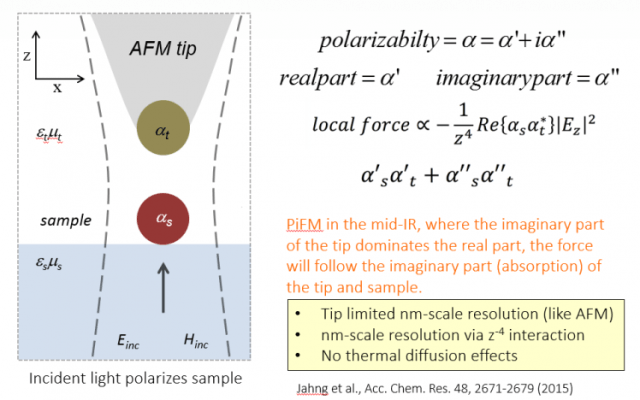
Optical Access 360°
Optical access from the side, top and inverted geometry is enabled with the VistaScope platform. The infrastructure that enables these pathways was designed to meet the requirements of users seeking a ‘black box’ solution as well as those interested in customizing their optical pathways.
Users are provided with the flexibility to hack into their system and design a specialized experiment, due to standard cage-mounting. However, the VistaScope will be installed by Molecular Vista with optics aligned, ready for near-field signal on the user’s very first day, and it is possible to maintain this configuration with little to no effort for the user.
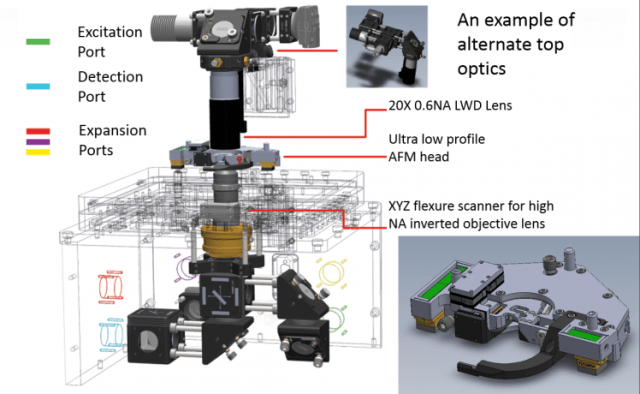
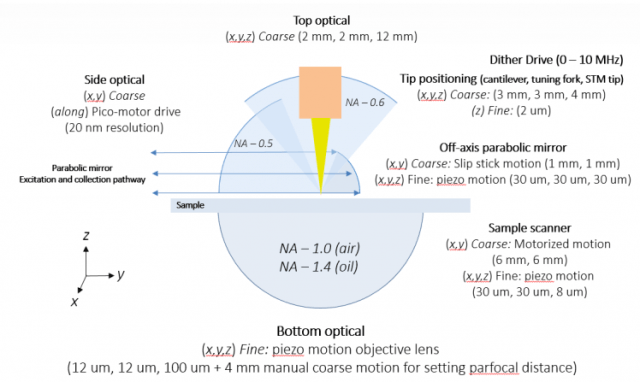
Technical Info
AFM-BD Head
AFM-BD (Beam Deflection) Head is the standard AFM head that comes with VistaScope. An ultralow noise sensor (< 25 fm/Hz½) is one of it's features, with an integrated parabolic mirror for effective side illumination/collection for PiFM and scattering SNOM on opaque samples. The AFM-BD Head is highlighted by the following features:
- Simple-to-use open liquid cell
- Rigid yet simple-to-change cantilever holder
- High speed Z-piezo for dual-z feedback control
- Adjustable focus size for ultra-small cantilevers
- Fabricated out of invar for thermal stability
- Photodiode bandwidth: DC to 6 MHz
- Manual offset XY stage for coarse tip-laser (external) alignment
- Choice of 650 nm or 980 nm laser for beam deflection sensor
- Integrated parabolic mirror with 3D piezo-motor alignment stages
- Ultra low profile (11 mm thick) for use of high NA (0.6 NA) top objective lens
Frame/Stage/Scanner
The frame is custom designed to be stable and rigid; its footprint matches an active vibration isolation table (optional) in order to attain ultimate stability. The typical noise level is below 0.05 nm RMS with a functional high NA inverted optical microscopy setup. The standard setup features:
- Optional active vibration isolation table
- Compatible with inverted/side/top optics
- Motorized XY sample stage (+/- 3 mm)
- Motorized sample approach
- 40 x 40 x 10 µm3 flexure scanner
- Scanner fabricated out of invar for thermal stability
- Both motorized stage and scanner with hole for inverted objective lens
Top Optics
Configuration of the top optics helps to provide a clear view of the sample surface and the cantilever with zoom capability. It is possible to modify and augment the flexible configuration in an effortless manner as the configuration is based on a standard cage system. The standard setup features the following:
- LED lighting
- CCD viewing
- Motorized focus
- 20X, 0.6NA LWD lens
The figures below display two of many configurations capable of being accommodated with the top optics due to use of the cage system.
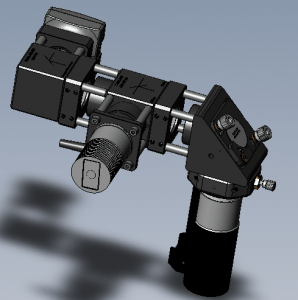
Standard configuration of the top down optics where it is primarily used as a zoom-capable cantilever/sample monitor.
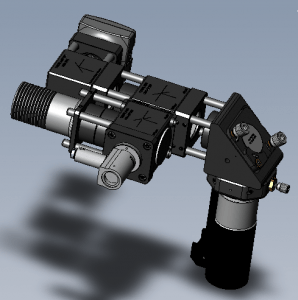
An alternate configuration where in addition to its function as cantilever/sample monitor, a fiber-coupled laser can be collimated and focused onto the tip/sample region.
Examples of the CCD views are shown below. The repeating features shown in the CCD view have a pitch of 10 µm.
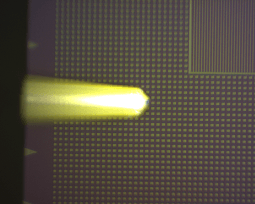
100% CCD View
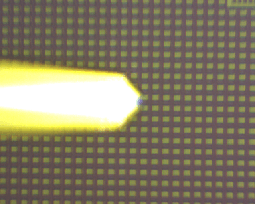
200% CCD View. The zoom extends to 600%.
Side Optics
Fully compatible with both the top and inverted optics, two side optical configurations are available: one configuration is based on the integrated parabolic mirror and the other is based on a side objective lens.
Parabolic Mirror:
- Scattering SNOM interferometric detection
- Fiber or freespace optical excitation and detection
- User exchangeable dichroic, emission filters, and excitation filters
- Raman, fluorescence, and photoluminescence collection
- PiFM compatible
Side Objective Lens:
- Camera view of sample tip area
- Objective lens: 0.42 NA LWD
- 100 mm tube lens (other options available)
- Fiber or freespace optical excitation and detection
- User exchangeable dichroic, emission filters, and excitation filters
- Raman, fluorescence, and photoluminescence collection
- PiFM compatible
Inverted Optics Module
Fully compatible with both the top and side optics, the inverted optics permits the use of the highest NA objective lenses for transparent substrates.
- 150 mm tube lens
- PiFM compatible
- Camera view of sample tip area
- Fiber or freespace optical excitation and detection
- User exchangeable dichroic, emission filters, and excitation filters
- High NA oil coupled objectives and reflective objectives (for mid-IR)
- Raman, fluorescence, and photoluminescence collection
- Supports objectives with parfocal length of 45 mm by design, however other lengths can be considered
The frame has a variety of expansion ports in order to incorporate additional light sources and detectors for diverse imaging modes.
Controller
Two inputs with 500 million sampling per second (MSPS) capability with four 2-phase lock-in amplifiers enables it to be a future-proof controller with enhanced capabilities unavailable from any other AFM controllers. In addition to the functions available in other high-end AFM controllers, some of the novel features include:
- Versatile spectroscopy function that permits monitoring of any signal as a function of tip-sample spacing
- Dual-z feedback capability provides for control of two z-piezo scanners, one with high bandwidth (on the tip) and the other with a modest bandwidth (on the sample) in order to attain large range as well as high-speed and extremely accurate z movements
- Multiple feedback modes: Contact and dynamic mode AFM, STM and PLL (for high Q sensors such as tuning fork)
- Sophisticated two-channel modulation output from the integrated lock-in amplifiers for current modulation of Bragg cells, diode lasers, or other external devices for sensitive lock-in measurements concurrent with AFM topography measurements
- Concurrent imaging of multiple modalities at multiple frequencies (for example, scattering SNOM signal at the third harmonic of the dither frequency, AFM topography at dither frequency, and SKPM signal at the second mechanical resonance of the cantilever all at the same time)
- Support for an advanced Raman spectrometer for confocal and tip-enhanced spectral Raman and fluorescence imaging and single-photon counters
- Patented lock-in detection for background suppression of scattering SNOM
- Side-band force gradient measurements for various types of tip-sample interaction forces
Software
VistaScan
VistaScan offers a simple-to-use and comprehensive interface to fully access and utilize VistaScope’s enhanced controller and its multitude of hardware components.
- UI for scattering SNOM with background suppression
- UI for image force and stimulated Raman force microscopy
- UI for scanning Kelvin probe microscopy (force or force gradient methods)
- Automatic Detection of 1st and 2nd resonances for multi-modal imaging
- Dual-Z Feedback for use of both standard and fast Z-piezo elements
- Lock-in amplifier UI to acquire multiple force and force gradient signals
- Customizable signals to modulate external lasers or Bragg cells
- Powerful spectroscopy to obtain multiple channels vs gap spacing Q-control
- And many, many more …
SurfaceWorks
SurfaceWorks is an intuitive and powerful image process and analysis package. All of` the processes and analysis are applied as functions to images while maintaining the raw data files intact.
- Shape-based and histogram-based masks
- Multi-image comparison
- Multi-channel comparison
- Flexible image management
- Batch processing by copying and pasting functions
- Preview feature for most functions (see example of palette below)
- All functions (palettes, 3D render properties, flattening, line and region analysis, etc) associated and transferable with raw image files
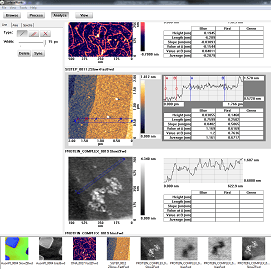
Screen capture of Line Analysis function. The analysis is saved with the raw data file so that it is displayed when the image file is loaded next time.
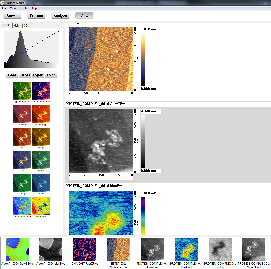
Screen capture of Palette function. The preview of the image with various palettes is shown on the left panel. Any of the pre-defined palettes can be edited and saved as a new palette.
Specifications
Beam Deflection AFM Head (AFM-BD)
- Body profile: 11 mm thick
- Body material: Invar for exceptional thermal stability
- Detector vandwidth: 6 MHz
- AC detector noise: <25 fm/root Hz above 100 KHz
- BB laser source: 650 nm or 904 nm
- Manual translation stage: 3 mm movement in XY for coarse tip alignment to external laser (for tip-improved spectroscopy)
- Focus Size: adjustable to accommodate a variety of cantilevers including the ultra-small ones for high speed imaging
- Optional component: Integrated parabolic mirror with 3D piezo-motor stage for reflection mode s-SNOM and PiFM
- Operational Mode: ambient or open liquid cell
- Fast-Z module: 1 um z-piezo as the fast-Z element of dual-Z feedback system
Forward Facing Tuning Fork AFM Head (AFM-FFTF)
- TF operation: Tapping-mode
- Body Material: Invar for exceptional thermal stability
- Integrated tip scanner: XY flexure stage scanner for the TF with 12 um x 12 um range
- Fast-Z module: 1 um z-piezo as the fast-Z element of dual-Z feedback system
- Manual translation stage: 3 mm movement in XY for coarse tip alignment to external laser (for tip-enhanced spectroscopy)
Main Body Frame
A custom designed inverted optical microscope with rigid and compact frame serves as the platform for super high resolution microscopy.
- Tip alignment mechanism: Piezo-driven XYZ stage (12 um for XY and 100 um for Z) for the inverted objective lens for precise alignment of the focus spot onto the tip
- Top objective lens: 20X, 0.6NA
- Top objective lens focus: Motorized
- Inverted objective lens: 100X, 1.4NA Oil; 60X, 0.9A Air
- Illumination: Software controlled LED
- Tip-sample approach: Automated engagement via 3 stepper motors
- CCD camera: Concurrent top and inverted views with 1280 x 1024 pixels each; digital zoom, capture, and pan
- Maximum sample size: 25 mm x 25 mm x 5 mm
- Sample stage: Motorized precision stage with 6 mm x 6 mm travel range
- System noise: <50 pm RMS (dependent on environment)
- Side optics module: Available as option for scattering SNOM, PiFM, and TERS on opaque samples
- Sample scanner: XYZ flexure stage scanner with 40 um x 40 um x 10 um for open loop; 30 um x 30 um x 7 um scanning range (closed loop); Z sample scanner serves as the slow Z component of Dual-Z feedback system; other ranges available upon request
- Optical configuration: Based on standard 1" cage system for expansion flexibility
- Scanner material: Invar for exceptional thermal stability
- Optional components: Active vibration isolation table for low noise performance
- Scanner sensor noise: 1 nm for XY with 40 kHz bandwidth 0.5 nm for Z with 40 kHz bandwidth
High-Speed Electronics
A section of FPGA-based control electronics is dedicated for high speed scanning probe microscopy.
- Lockin amplifiers: 4 independent 2-phase lockin amplifiers (LIA0 to LIA3)
- Sampling Rate: >500 MHz for channels A and B; Channel A dedicated for photodiode detection for high speed AFM
- Maximum feedback throughput: 1 Mps with dual-Z feedback
- LIA operation frequency: Up to 10 MHz
- High speed feedback mode: Dual-Z feedback where the Fast-Z Module in the AFM head tracks the fast varying topography and the sample scanner tracks the slow varying topography
- High speed sine wave generator: Two channels with 160 MHz sampling rates; one reserved for scan generator for high speed AFM
Standard-Speed Electronics
- DACs: 8X 24-bit 156 kHz; 2X 24-bit 156 kHz; 1X 20-bit, 156 kHz
- Stepper motor control: 3 channels
- ADCs: 8X 24-bit, 156 kHz; 4X 24-bit, 156 kHz
- DC motor control: 3 channels with encoders and Schmitt-Trigger for enhanced signal quality
- Noise floor for scan HV-Amplifiers: 140 uVrms for 150 V full range
- HV-Amplifiers: 10 channels
PiFM and Optics Electronics
Electronics for PiFM includes:
- Digital counter input: Input for APD and PMT for low-lighting imaging
- Flexible lockin referencing: The LIAs can be phase locked at any calculated frequencies from the other LIAs or to any other LIA
- TTL signal generator: Two flexible TTL signal generators (with 160 MHz sampling rate) with adjustable duty cycle and DC offset for direct current modulation of laser diodes or for input to Bragg cells
Computer
Mounted in a 19" rack. Minimum configuration includes 4GB RAM, 3.4GHz Quad Core, 256 GB SSD and 2000 GB HD combination, Windows 7 Professional, 8X USB ports, 26" or larger monitor
VistaScan Image Acquisition Software
Supported modes/features include:
- STM and PLL feedback (for high Q sensors such as tuning-fork)
- Ultrafast dual-Z feedback
- Contact and AC AFM
- Q-control
- Sideband force gradient imaging (for KPFM via electric force gradient detection)
- Bi-modal force gradient imaging for non-linear and linear PiFM
- Concurrent acquisition of 26 channels in dual-Z configuration and 40 channels in slow-Z configuration
- Concurrent acquisition of 4 channels for each spectroscopy mode which may include
- vs bias with and without feedback
- vs gap distance
- step response to voltage response with and without feedback
SurfaceWorks Image Analysis Software
Intuitive and powerful software. Features include:
- Shape and histogram-based masks
- Analysis and functions and (flattening, line and region analysis, FFT filtering, palettes, 3D rendering, etc) applied to an image saved as a file property along with the raw data file
- Copy/paste file property to apply same functions and analysis to other image file(s)
- Preview feature for almost functions
Acoustic Enclosure
It is possible to order an optional acoustic enclosure (30 W x 30 D x 27 H in3) without or with temperature control; available with ports for cables as well as optical access